Bogor - city in West Java Province, Indonesia
 Bogor is a city in the Bogor Raya region of Western Java, Indonesia. With almost a million inhabitants, modern Bogor is the 6th largest city of Jabodetabek (Greater Jakarta metropolitan area) and the 14th nationwide. In the Middle Ages, the city was the capital of Sunda Kingdom under name of Pakuan Padjajaran. Its name changed during the Dutch colonial period to Buitenzorg, meaning "without care" in Dutch. The city changed its name to "Bogor" during the Japanese occupation.
Bogor is a city in the Bogor Raya region of Western Java, Indonesia. With almost a million inhabitants, modern Bogor is the 6th largest city of Jabodetabek (Greater Jakarta metropolitan area) and the 14th nationwide. In the Middle Ages, the city was the capital of Sunda Kingdom under name of Pakuan Padjajaran. Its name changed during the Dutch colonial period to Buitenzorg, meaning "without care" in Dutch. The city changed its name to "Bogor" during the Japanese occupation.
Originally a mountain resort town, it is now a densely populated city that is part of the Greater Jakarta metropolitan area. The city is most famous for its presidential palace and the extensive botanical gardens (Bogor Botanical Garden), which is one of the oldest in the world. The city is also famous nationwide for its education, especially in Agricultural Science.
Understand
Some 60 km south of Jakarta, Bogor is the "bo" of the massive Jabotabek conurbation. The city has a population close to 1,1 million (2018) people, and the regency that surrounds it has a population close to 5.1 million people (2014). The town was the capital of Indonesia during the brief British occupation, and under the name Buitenzorg was also the summer capital of the Dutch in the hot dry season. Located 290 meters above sea level, Bogor is noticeably cooler than the torrid lowlands, and the place where many of the Indonesian elite have their villas. Once a place of beauty, rapid development has turned central Bogor into the same congested mess as every other Indonesian city, but there are still rivers, canals, red-roofed houses, mosques, churches, trees, flowers and views of nearby Mount Salak.
- Bogor Tourist Information Centre, ln Kapten Muslihat N0. 51 +62 251-8363433 . Open daily from 08:00 - 19:00
History
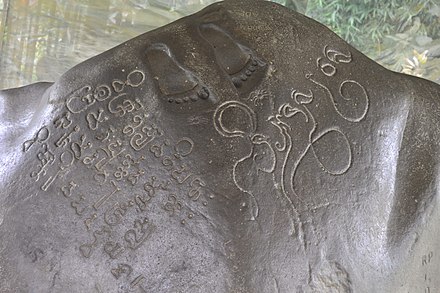
After Tarumanagara was defeated by the neighbouring Srivijaya, the kingdom was succeeded by the Kingdom of Sunda. The kingdom reigned over much of western Java, and Bogor was chosen as its capital under name of "Pakuan Padjajaran". In old Sundanese, the name "Pakuan Padjajaran" means "a place between the parallel [rivers]".
It was one of the largest cities in medieval Java, with well over 48,000 inhabitants. After Sunda was defeated by the neighboring Sultanate of Banten, most of the area became neglected and remained mostly uninhabited for decades.
In the middle of the 17th century, the Sultanate of Banten was brought under the control of the Dutch East India Company (VOC). The first temporal colonial settlement was a camp of lieutenant Tanoejiwa, a Sundanese employed by the VOC. Due to its relatively fertile soil, the Dutch transformed Pakuan into a plantation area. In a relatively short time, several agricultural settlements appeared around Pakuan, and, in 1701, these settlements were merged into a single administrative district. In 1744–1745, the residence of the Governor-General (now Bogor Palace) was built and became the seat of government during the summer.
In 1746, by the order of the Governor-General Gustaaf Willem van Imhoff, the Palace, a nearby Dutch settlement and nine native settlements were merged into an administrative division named Buitenzorg (Dutch for "beyond (or outside) concerns," meaning "without worries" or "carefree". Buitenzorg became the main summer getaway for Dutch colonials because of the beautiful plantations and surrounding mountains, and also because it was (and is) noticeably cooler than VOC's capital, Batavia (present-day Jakarta).
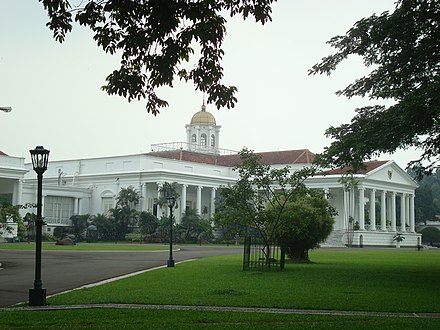 Buitenzorg grew rapidly during the following years, and this growth was partly stimulated by the temporary occupation of the Dutch East Indies by the British in 1811–1815. The head of the British administration, Thomas Stamford Raffles, re-landscaped the garden near the palace into an English-style garden. This garden later became what is now known as the Bogor Botanical Garden. Raffles also moved the administrative center from Batavia to Buitenzorg and implemented new and more efficient management techniques.
Buitenzorg grew rapidly during the following years, and this growth was partly stimulated by the temporary occupation of the Dutch East Indies by the British in 1811–1815. The head of the British administration, Thomas Stamford Raffles, re-landscaped the garden near the palace into an English-style garden. This garden later became what is now known as the Bogor Botanical Garden. Raffles also moved the administrative center from Batavia to Buitenzorg and implemented new and more efficient management techniques.
Buitenzorg, along with the rest of the formerly Dutch colonial possessions they had occupied, were returned to Dutch rule under the Anglo-Dutch Treaty of 1824. The Dutch continued to develop the regency and by the end of the 19th century, Buitenzorg became one of the most developed and Westernized cities in Indonesia.
During World War II, Japanese forces occupied Buitenzorg and the rest of Dutch East Indies. The city's name was changed to "Bogor" in an effort to gain support from Indonesian nationalists.
Today, Bogor has a significant role in the cultural, scientific and economic development of the country and West Java in particular – in part due to its colonial legacies such as infrastructure. Bogor also become a center of education, especially in Agricultural Science.
Local people
Bogor, like many parts of western Java, is inhabited by ethnic Sundanese people.They are overwhelmingly Muslims, but some pocket of ancient Javanese Hinduism still survives. More traditional Sundanese still adhere to Sunda Wiwitan, an ancient belief system. Their native language, the Sundanese language, is practically spoken by everyone here, along with Bahasa Indonesia. However due to the bilingual nature of the locals, learning Sundanese is not essential to communicate. Other ethnicities include considerable numbers of Betawi, Javanese, Chinese and others, often mixed ethnicities.
People in Bogor are extremely friendly and will go out of their way to help you. Be polite and smile, and it will get you far. English is not prevalent, but basic English is spoken by many in restaurants and in the local warung food-stalls.
If you are a Westerner be prepared for Indonesians asking you for a photo. Do not be shy. They just enjoy visitors to Bogor, and posing for a photo with a smile can make someone's day.
Climate
Bogor's epithet is Kota Hujan, meaning "City of Rain". Statistically, it's the rainiest city on Java, and locals jokingly advise getting any sightseeing done in the morning because it's guaranteed to rain in the afternoon. Then again, tramping through the Gardens can actually be more pleasant in a cool drizzle. Lovers of Bogor will tell you that most of the time it is dry; normally, the rain falls only in heavy bursts late in the day.
Get in
By plane
The nearest major international airport is Jakarta's Soekarno Hatta International Airport.(IATA: CGK) There are direct Damri buses from there to Bogor Rp 55,000 every 30 min (1-2 hours, depending on traffic). If you charter a helicopter from Soekarno Hatta airport, you can request in advance for permission to land at Atang Senjaya airport, Bogor. This airport is a military base, but it may be used for civilian flights in the future.
By train
Bogor railway station 📍 is the southern terminus of the yellow and red lines of Jakarta's commuter rail network (KA Commuter Jabodetabek). Both lines run from Jakarta via Depok to Bogor, with the red line trains originating at Kota station in West Jakarta, and the yellow line trains originating at Jatinegara station in East Jakarta. Trains of both lines call at several stations in South Jakarta as well, while red line trains call at Gondangdia station in Central Jakarta, near the famous backpacker's street Jalan Jaksa.
Bogor Paledang railway station 📍, which is about 200 metres from the central Bogor railway station, is served by three daily trains to and from Sukabumi (about 2h 15m, economy and executive class).
In a few years, you can access Bogor and its surroundings by the new LRT. This LRT can also bring you to Bekasi, another city, also in the Jabodeta__bek__ sphere. (The bolded "bek" refers to Bekasi.)
By bus
There are direct Damri buses from Jakarta's Soekarno Hatta International Airport to Bogor for Rp 55,000.
Buses also go to Bogor from Jakarta, Bandung, Sukabumi, Yogyakarta and even further cities like Malang.
Buses from Jakarta depart from Lebak Bulus, Kampung Rambutan and Kalideres bus terminals and take about 1-2 hours depending upon the traffic. There are two types of buses available: Executive (air conditioned) and Economy.
Buses from Bogor to Bandung takes about 3 hours. Executive buses use the Cipularang highway route while the Economy buses are still using the old route via Puncak Pass. During weekends they may take a loop through Sukabumi, adding an extra hour.
By car
The easiest way to get to Bogor is to hire a car and a driver; this is relatively cheap. Or, you can rent a car. There is more than one road to Bogor, and the minor roads are often the most interesting and congested. With Tol Jagorawi, Bogor is about 40 minutes to 1 hour from Jakarta. During traffic jam (rush hours), it may take significantly longer, and during weekends and holidays, the trip from Jakarta to Bogor may take even up to 3 hours. Tol Jagorawi is 48 km, and the exit to Bogor is at, or approximately, KM 40.
By taxi
You can take metered taxi to Bogor from Jakarta. The cost will be approx. Rp.250,000-500,000, plus toll road fees of about Rp.30,000. The trip may take up to 3 hours on old roads and 40 minutes to 1 hour on Tol Jagorawi, depending on the traffic. Be cautious during the rainy season (Nov - Mar) because the route to Bogor is subject to flash flooding. It's better to use bigger companies like the Blue Bird Group because with the biggest fleet between Jakarta and Bogor they are the most reliable.
Get around
There are many pleasant traffic-free walks in Bogor, alongside rivers and canals.
The traffic in Bogor is chaotic. There is a daily traffic jam in Bogor from early in the morning to late in the afternoon. On weekend and holiday, people from Jakarta often go to Bogor with their cars.
By minibus
The easiest way to get around Bogor is by angkot, little green minibuses, hordes of which infest Bogor's central streets. Any trip from anywhere to anywhere costs Rp 2,000, paid when you get off.
The downsides to using angkot are that the drivers are reckless and theft is all too common (guard your belongings). Also, some angkot like 02 or 03 only depart from their pangkalan (terminals) when full — 10 min on a good day on a busy route, 90 minutes on a bad day on an unpopular one.
By horse cart
Horse carts known as delman can be found in central Bogor, and it could be an option if you want to cruise around and take a look at the city. The poor beasts aren't very comfortable in the traffic scrum, though.
By taxi
Blue Bird Taxis operate in Bogor but prepared as they generally can turn up late or sometimes not at all, make sure you call 10 min after ordering to check it is coming. Allow an extra half an hour for your airport taxi. Ride-hailing-app services such as Go-Car (from Gojek) and Grab are also available.
See
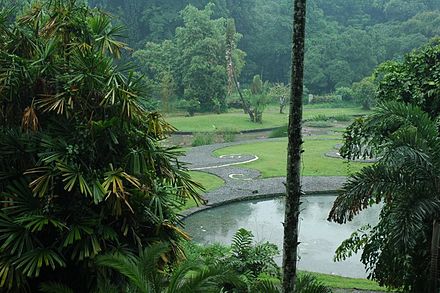
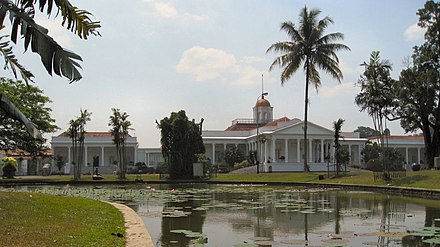
-
Bogor Botanical Gardens (Kebun Raya Bogor), Jl. Ir. H. Juanda No. 13, Kota Bogor, Jawa Barat (a number of local angkots pass the entrance.), -6.597937°, 106.799112°, +62 251 8311362, Info@kebunraya.id. M-F 08:00-16:00, Sa Su and national holidays 07:00-16:00. The Bogor Botanical Gardens (Kebun Raya) is Bogor's pride and joy. The extensive Botanical Gardens were founded in 1811 as a private garden of the Governor-General's summer residence by Sir Stamford Raffles, who also went on to found Singapore. However, it was Casper Reinwardt who adopted the gardens and directed their scientific use, with Johannes Elias Teysmann continuing in his footsteps. Today, the gardens stretch out over 87 hectares, including some carefully manicured gardens as well as areas that look and feel like wild jungle. Fountains, lakes, two rivers and hilly trails make for interesting walking that can easily take 2 days if you really want to see it all. If you visit in January you may be able to spot a blooming giant arum (Amorphophallus titanum), the world's tallest inflorescence (flower cluster) which can reach an astounding 2.5 m and smells like rotting meat. The walk around the garden can be long. Taking the tour bus for a quick trip around the garden will give you some better information about planning your walk on foot. Beware of falling trees in case of storms or wind. M-F Rp 16.500 for domestic and international tourist, Sa Su and national holiday Rp 26.500 for domestic and international tourist 2018-01-18
-
Presidential Palace (Istana Bogor), -6.597996°, 106.79735°. in the northwest corners of the Botanical Gardens. Built as the summer residence of the Governor-General of the Dutch East Indies, now one of the Indonesian president's summer escapes and noted for the 250 tame deer grazing in its grounds. The palace grounds can be visited from within the Gardens, but tours in the palace require 5 days advance notification — however, the Bogor TIC (see Connect) may be able to squeeze you in at short notice if there's a tour going on. 2016-09-26
-
Orchid House at Bogor Botanical Gardens (Rumah Anggrek), -6.595422°, 106.803223°. Located in the northeast corner of the Botanical Gardens. Large greenhouse housing orchids of all shapes and sizes, with two separate halls so there's always something blooming. Entry is included in the Botanical Garden entry fee.
-
Museum of Zoology, Jl. Ir. H. Juanda No.9 (also next to the botanical gardens (southwest corner)), -6.603611°, 106.796944°. 08ː00-15ː00 daily. Museum about the animal kingdom. 2020-10-11
Monuments
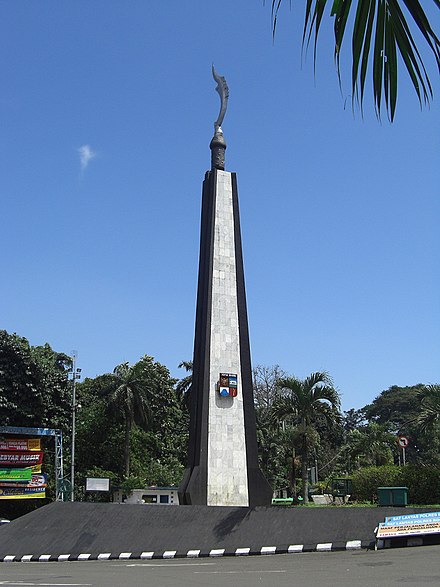 Kujang, -6.601446°, 106.80504°. This statue commemorates the struggle for Indonesian Independence by people in West Java. Kujang is a traditional weapon from West Java.
Kujang, -6.601446°, 106.80504°. This statue commemorates the struggle for Indonesian Independence by people in West Java. Kujang is a traditional weapon from West Java.- Prasasti Batutulis, -6.623664°, 106.808966°. A carved stone to commemorate King Sri Baduga Maharaja from Kingdom of Pakuan Pajajaran. Created in 1533 by King Surawisesa, son of King Siliwangi Sri Baduga Maharaja (according to Kern/Pleyte and Danasasmita).Prasasti Cirauteun, -6.527794°, 106.691273°. At Cirauteun, Ciampea, Bogor. A large carved stone to commemorate King Pakuan from the Kingdom of Taruma (5th century).
- Taman Safari Indonesia, Jl. Raya Puncak No.601, Cisarua, Bogor, -6.72032°, 106.951°, +62 251 250 000. A beautiful safari park/zoo in Puncak.
Do
Tourist mini bus
A half side open tourist minibus with capacity of 25 persons is called UNCAL or Unforgettable City Tour at Lovable City run a circle of Botanical Garden in one way direction for free. Start and finish at Botani Square.
Amusement Parks
- The Jungle Water Adventure, Jalan Bogor Nirwana Boulevard, Perumahan Bogor Nirwana Residence, Mulyaharja, Bogor Selatan, 16132, -6.63419°, 106.79456°, +62 251 8212666. Weekdays 09:00-17:00, weekends 09:00-18:00. An amusement park featuring water slides and other recreational attractions. Unfortunately, this place has been closed since COVID-19 rise up. 2018-06-01
- JungleLand Adventure Theme Park, Jungleland Boulevard 1, -6.57413°, 106.89359°, +62 21 29311313. M-F 10ː00-18ː00, Sa Su 09ː00-18ː00. Other amusement park with jungle in the name, this one more centered around thrill rides and theatrical shows. 2020-10-11
- Devoyage Bogor, -6.63735°, 106.79526°. M–F 09:00–18:00; Sa Su 09:00–19:00. Boat rides in a European-themed setting. Or you could just get your selfie in front of the Eiffel Tower replica. 2020-10-11
Retreat
- One Earth Retreat Center (Anand Ashram's), Jl. Raya Bukit Pelangi Km 2, Ciawi, -6.63233°, 106.87701°, +62 21 2884 7976. Tu Sa 08:00-16:00; Su 08:00-12:30. Meditation, yoga, self development programs, stress management. Sessions are about 90 min long. Rp 50,000-150,000 2016-12-01
Walking
There are many traffic-free walks by the side of rivers and canals. One is reminded, if one squints, of Venice in earlier days. One is likely to encounter colourful little houses and gardens, children flying kites, people bathing, vendors of snacks and spectacular views of Mount Salak. On the edge of Bogor one can walk beside rice fields and fruit orchards.
Fishing
- Fishing Valley Bogor, Jl. Pemda Raya No. 107, -6.53571°, 106.80536°, +62 251 865 8722. Daily 09:30-21:00. The biggest fishing venue in Bogor. Freshwater fishing in a valley with Mount Salak view. Carp, catfish (lele, patin), Nila, etc). 2016-12-01
Golf
- Riverside Golf Club, Cimanggis, -6.42°, 106.8957°, +62 21 8671533. Tu-Su 05:00-18:00. Golf course designed by Greg Norman. A cart-only course. 2016-12-01
- Klub Golf Bogor Raya, -6.598°, 106.83609°, +62 251 271888. Daily 5:00-19:00. Bogor, adjacent to Perumahan Danau Bogor Raya. 18-hole golf course designed by Graham Marsh Golf Design. It is at an altitude of 500 metres above sea level and the setting is natural, with mature trees, natural rivers and lakes. The golf course measures 6195 metres, par 71 with four sets of tee boxes (black, blue, white and red). 2016-12-01
- Rainbow Hills Golf Club (Bukit Pelangi), Jl. Raya Bukit Pelangi, Ciawi, -6.6205°, 106.88426°, +62 251 272111. 10 km from Bogor city. J. Michael Poellot Golf Design Group designed the course. 2016-12-01
- Rancamaya Golf and Country Club, Jl.Rancamaya Utama, Ciawi, -6.6607°, 106.82076°, +62 251 824 2282. Designed by Ted Robinson. 2016-12-01
- Jagorawi Golf & Country Club (JGCC), Jl. Karanggan Raya, Cibinong-Bogor, -6.45889°, 106.88348°, +62 21 8790 2488. Daily 5:30-18:30. The only golf club in the country that offers 45 holes of championship golf. 2016-12-01
Buy
Markets
Most exciting are the traditional markets, filled with cheap clothing, toys, fruit, vegetables and the like. You should come every Sunday morning in Sempur for "in the morning" shopping while you have exercise. Tons of things and food for breakfast.
Shopping malls
- Botani Square, Jl. Raya Pajajaran (In front of Tugu Kujang/Kujang Monument), -6.601061°, 106.807075°, +62 251 838-6658. Food court, convention centre, meeting point. A prestigious shopping mall in Bogor. Easy to access via public transportation. Located next to Terminal (Bus Station) Baranangsiang. 24 hr ATM. It is also recommended for city check-in, with an airport bus to take you directly to Jakarta's CGK International Airport. Located also next to Botanical Garden and Bogor Agriculture Institute.
- Bogor Trade Mall, Jl. H. Juanda. Food court.
- Eka Lokasari Plaza, Jl. Siliwangi 123. Food court.
- Pangrango Plaza, Jl. Raya Pajajaran. Food court.
- Bogor Plaza, Jl. Surya Kencana. Food court.
Eat
Bogor's local specialities include pickles (asinan) and grilled bean sprouts (tauge goreng).
- De Daunan, east side of Botanical Gardens. Formerly Cafe Botanicus, serves up a mix of Dutch and Indonesian favorites, with lazy ceiling fans and a breezy veranda on a small hill looking over the garden. The rijsstaffel set is popular if a bit pricy at Rp 45,000.
- Sotomie Ciseeng. Jl. Suryakencana No. 302. A type of noodle with beef tendons and deep fried chives.
- Ngohiong, sold along Jl. Suryakencana. An originally Chinese dish (五香 wǔxiāng) made from flour and scraps of pork, deep fried and then served with tofu, fried potato wedges, a thick sweet sauce and pickles. Halal (non pork) version of the dish may also be available.
- Gang Selot, at Jl. Ir Juanda, next to SMU Negeri 1 Bogor. This is a good place for a food lover. Various food outlets with very cheap price.
- Harly's Cafe and Resto, Dadali Street No. 10 (near Goodyear factory and Immigration Office), +62 251 8347928. Serves good food including pizzas but only a few brands of beers other than the locals, Bintang and Anker. The spirits are expensive and most likely watered down and the atmosphere reminds one of something Charles Bukowski may have enjoyed. Dark and smokey and typically filled with older expats and women looking to take their money.
- Ngeces Dimsum-Pasta, Jl Soleh Iskandar (In front of Yogya Dept Store, Cimanggu, and FoodCourt Ekalokasari Plaza), +62 813 8097 3972. 10:00-22:00.
Drink
- Salak Sunset Cafe (Sunset), -6.601358°, 106.79244°. Quaint cafe owned by an expat who has been in the city a long time. This is a popular place to have a beer with some freshly cooked peanuts. Wonderful view of the sunset over Salak Mountain. Rp.28,000/Tall Bintang
- Chiers Sportscafe (Harly's), Jl Dadali 10 (07 angkot will take you right by the front door.), -6.568244°, 106.801118°, +62 251 8347928. 16:00-03:00 daily. Excellent ambiance with the feel of a Dutch pub. Excellent food and standard bar fare including popcorn, peanuts and Dutch bitterballen. Try the Schoarma Schotel with a cold Heineken.
- Bali Blitz, 48A Veteran Street Bogor (10 min walking from Bogor train station towards Jembatan Merah area (away from Kebun Raya).), -6.594686°, 106.784662°, +62 251 838 3368, orentzgroup@gmail.com. 24/7. Asian, fried rice and other Indonesian foods, served with spicy characteristics. 1st floor has a cafe and an internet cafe, 2nd floor has Bali blitz providing 2 music studio rooms and 4 cozy karaoke rooms, 3rd floor has a full bar, with selection of beers and cocktails, a wide dance floor, private section and DJ booth.
- X-One Club Lounge & Music Center (X-One), Jl. Siliwangi No 25 (take angkot 2 (green and orange)), -6.617209°, 106.811571°. 09:00-04:00 daily. X-One sits across from Circle K on Jln. Siliwangi. It's open almost every night, and Wednesday, Friday and Saturday are your best bets if you want to dance with a couple hundred other people. It's smoky, it's loud, and there are air conditioners every 2 metres doing their best to keep it cool. Billiard downstairs. Rp.50,000 (includes a free Coke)
- Lipss Karaoke Bar and Club (Lipps), Jl. Sukasari 1 No. 5 (Take angkot 02 (orange and green) to Dunkin Donuts (next to X-One) and walk down the hill past Indomaret.), -6.617558°, 106.812225°, +62 251 328045. 21:00-16:00 daily. Dancing, drinking, karaoke and billiards. The billiard and karaoke are separate. Can be a little difficult to negotiate entry. There are extremely pricey "table and drink" packages on offer, but, if you ask, you can usually get in for the price of an over priced beer. From Rp.50,000 (negotiable))
- Mahoni Bar (Mahoni), -6.603679°, 106.838017°. Daily 09:00-00:00. Happy hour 18:00-20:00, buy 1 get 1. Live music every weekend 21:00-23:99. This is a cute little pagoda bar in the middle of the Novotel resort. It's quiet and friendly, and often quite empty. There's a free billiard table.
- Katulampa Lounge Bar, -6.635099°, 106.794886°. 08:00-22:00 daily. The Katulampa is located in the Aston Hotel and Resort. This is a premier hotel and offers a number of attractions next door as well as scenic, modern seating. You can also count on prices that will be higher, and some difficulty in reaching this location because no public transport routes go through the Bogor Nirwana Residence where the Aston Resort is located.
- Indomart, Alfamart, and Circle K. These all sell beer, and you can find one on almost every street. The sale of spirits of any kind in a retail establishment is against the law. Circle K is your best bet for a cold beer, and you may have to ask at the counter at Alfamart, which has been known to hide them on shelves in the stock room.
Sleep
Budget
- Hotel Bogor Inn, Jl. Kumbang No. 21, -6.589931°, 106.805896°, +62 251 832 8134. Cheap, near to Jl Malabar-the favourite place for students restaurants.
- Abu Pension, Jl Mayor Oking 15, -6.593885°, 106.789808°, +62 251 8322 893. Directly behind the railway station. Lovely food, nice terrace over river. Good info on what to do. Offers kampung tour of the small streets (200.000 Rp). Rooms: double/triple from Rp 125,000 excluding breakfast. Air-con room (double) from Rp 200,000 ex breakfast. Some budget rooms with shared (clean) toilet and shower.
- Tom' Homestay, Jalan Selot 32, -6.5978°, 106.7931°, +62 87770467818, toms.homestay@yahoo.co.id. Cheap place (fan, shared bathroom); near the botanical garden. Tom is very helpful and also organizes tours in the Bogor surroundings. Rp 100,000 2018-09-14
Mid-range
- Hotel and Restaurant Mirah Sartika, Jalan Dewi Sartika 6 (From Jl Dewi Sartika 100 m from KFC, enter in a cul-de-sac its on your right.), -6.595036°, 106.792653°, +62 251 831 2343. From Rp 350,000 for 2 persons, breakfast included
- Padjadjaran Suites, Jl. Raya Pajajaran No. 17, -6.640041°, 106.786461°, +62 251835 9000. Flat-screen satTV, tea/coffee making facilities and a safety deposit box. Each room has a balcony. Bathrobes, slippers and toiletries are provided. Outdoor pool, spa and gym. WiFi and parking are free. Business centre and meeting room facilities. Laundry and dry cleaning services are available, and a 24-hr front desk is provided. From Rp 900,000
Splurge
- Hotel Santika Bogor, Botani Square, Jl. Raya Padjadjaran, -6.60123°, 106.8069°, +62 251 840 0707. Underground connection to the Botanical Gardens and a large mall next door. The staff are friendly and helpful, and the interior is very clean with spacious rooms. IDR 554900 2016-09-16
- Novotel Bogor Golf Resort & Convention Center, Golf Estate Bogor Raya (near the 18 hole Klub Golf Bogor Raya), -6.60393°, 106.83859°, +62 251 827 1555. Conferencing, banqueting facilities and rooms set amongst tropical gardens. 2016-09-16
Stay safe
Bogor is called the 'rain city' due to the fact that Bogor gets more rain than all other cities in Java. Strong winds can occur once or twice a year with speeds of more than 100 km/h for one or two minutes, but never exceeding 200 km/h. Beware of collapsing trees. In January 2015, 4 people died and 21 people were injured when an 8-m long tree, 1.5 m in diameter tumbled and struck employees of one company when they were gathering in Kebun Raya Bogor.
Connect
The telephone area code of Bogor is 0251.
Go next
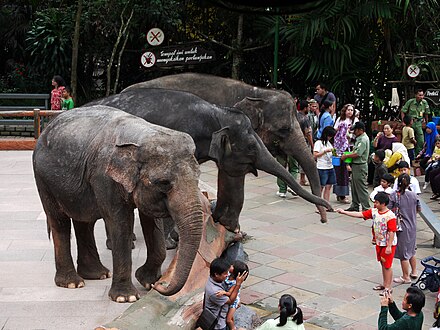
- Puncak — highlands and tea plantations along the road to Bandung.
- Citarik River - there are two white water rafting companies on this river about 2 hr out of Bogor on the Cikidang Road (turn right off Jalan Sukabumi after the petrol station). These companies are on the way to the beach in West Java, at Pelabuan Ratu. Great river all year round, but peak season is strangely the dry season (May–August), it gets more fun in the wet season, but more unpredictable. Great boats and good fun to be had, plus some bungalows by the river for sleeping.
- Taman Safari (20 km east of Bogor towards Bandung) has an impressive drive-through zoo with lions, tigers, hippos, rhinos, zebras, giraffes, as well as plenty of other animals is well-kept large enclosures. There are also some amusement park attractions for children, a water park, a baby zoo, as well as conventional zoo exhibitions including penguins, snakes, kangaroos and Komodo dragons. A very well maintained zoo and a much better than other zoos found in the region. Admission is around Rp 100,000 per person. When visiting with children reserve a full day, but 3 hr is sufficient.
- Sukabumi
- Pelabuhan Ratu
Bogor
kotabogor.go.idKota Bogor
2nd-order administrative division
West Java
Primary administrative division